This was published 8 years ago
Champagne, France's most famous wine region: Hillsides, houses and cellars
By Luke Slattery
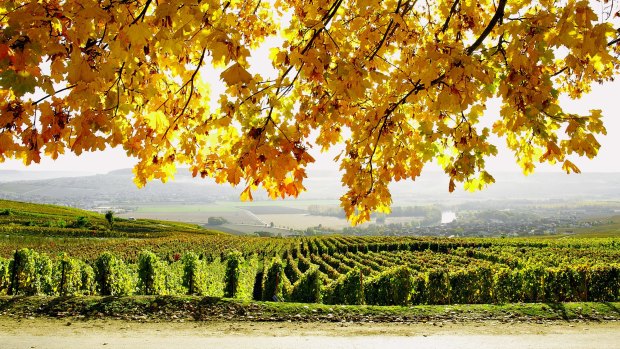
Vineyard in Champagne, France.Credit: Yves Talensac
There are plenty of viticultural reasons to visit Champagne. Such is the renown of the region's prestige champagne houses – from Mumm to Moet, Veuve Clicquot to Bollinger – that its cultural treasures get a little lost in the froth. A Gothic cathedral is always going to suffer beside everyone's favourite tipple.
In July last year a UNESCO World Heritage listing thrust the emphasis back on Champagne's cultural heritage, inviting visitors to see the region as a uniquely cultivated landscape in which geology, history, agriculture and human ingenuity intersect. It's a little easier now to appreciate Champagne's historic hillsides with their corduroy claddings of vine – only chardonnay, pinot noir and meunier are permitted – as the setting for a great story.
An appointment with the all-seeing deity is perhaps not high on everyone's to-do list. But it is on mine this late-December morning as I step out on a heritage tour prompted by the new UNESCO designation. Vinous hankerings – the popping of the cork, the first foamy pour, the clinking of glasses – are temporarily suspended as I stroll beneath the soaring nave of the Cathedral of Notre Dame at Reims (pronounced like France without the F).
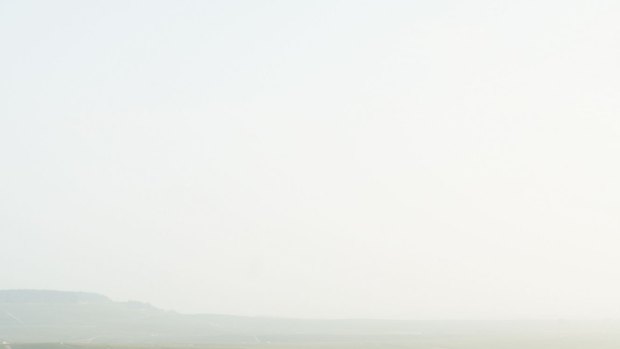
A man carries grapes during the harvest at Avize, Champagne, France.Credit: Louis-Laurent Grandadam
Those medieval architects certainly knew how get a message across: avert your gaze from the city of man; raise your eyes to the city of God!
The cathedral's buttressed pillars vault towards the heavens and from the clear mullioned windows of the clerestory plunge shafts of cold wintry light. Each of the key points of the cathedral's cruciform plan is decorated with gorgeous stained glass. The rose windows are regarded as one of the high points of Gothic art. But there is nothing shabby about the three modern glass windows in the chapel by Marc Chagall, completed in 1974.
It's my second visit to the cathedral – the first was almost two decades ago – and I've been looking forward to a rendezvous with the sumptuous 13th century statuary on the famed west facade.
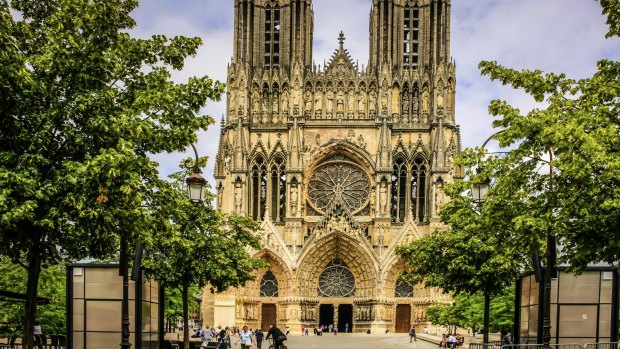
Our Lady of Reims Cathedral dating back to 1211 in the Champagne-Ardenne region of France.Credit: iStock
There's quite a crowd perched up there. I can make out a throng of Old Testament kings and queens, resplendently bearded saints and prophets; a tableaux of scenes from the passion of Christ; and a parade of French kings. The crowned Virgin Mary is naturally given pride of place above the central portal between the two rose windows set one above the other.
I'm searching for two particular figures recalled from that earlier visit, and they occupy opposite ends of the moral compass. One is a sculpture of a slender, smiling angel and she adorns the jamb of the northern portal. The other, of Eve cradling a snake with an apple in its mouth, is housed in the treasury of the adjoining Palace of Tau.
The sweetly smiling angel is a kind of civic mascot for Reims but on balance I prefer Eve. The snake, more of a mini serpent really, puts me in mind of Games of Thrones' Khaleesi and her trio of dragons in their nappy phase. But there is nothing sassy about this dragon lady; her expression is one of infinite sadness, dignity, and forbearance. In fact the closer I look the lovelier she becomes. She's no sinner; she's just a good girl who's made some bad choices.
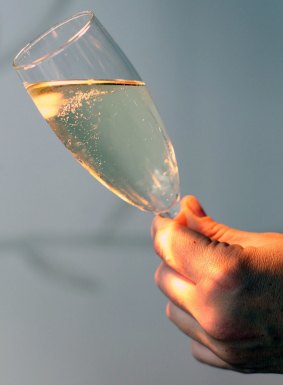
Champagne, as perfected by Benedictine cellarmaster Dom Perignon, remains the ultimate drink of celebration.Credit: Alamy
The cathedral is important for reasons that may be largely lost on foreign visitors for it is here – or hereabouts – that France itself was born when the Frankish king Clovis was baptised at the end of the 5th century after first uniting the Gallic tribes.
Clovis was merely the first of a procession of French monarchs to be crowned at Reims, and the cathedral is keen to remind you of its status as the coronation cathedral with a stately gallery of kings on the facade. Its place in the French imagination is heightened by the memory of its sufferings in the First World War, after which it was little more than a blackened shell. The town of Reims took a pounding in the next war, but was still able to serve as Allied HQ on the western front and to receive the German unconditional surrender. "Remember gentlemen it's not just France we're fighting for," Winston Churchill implored the troops, "it's champagne".
At Reims the ecclesiastical history is wrapped around the national story and Notre Dame – our lady – in effect shares the cathedral with Clovis and his hirsute heirs. The bishop who did the hard work converting Clovis, Remigius, is buried at the nearby basilica that bears his name. Saint Remi, which still retains some chunky Romanesque masonry from the 9th century, is more modestly proportioned than the cathedral and, on the day I visit, almost deserted. Walking the slender nave of Saint Remi, free of all the coronation hoo-hah, I breathe an older, purer air. Or that is how it seems.
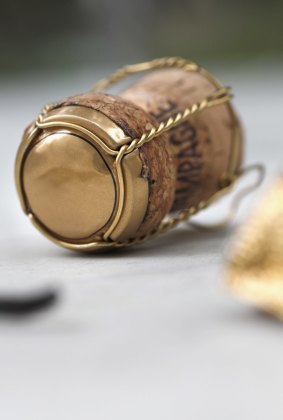
Who can resist the pop of a champagne cork.Credit: Marc Volk
A relic from deeper history is the 3rd century Roman triumphal triple arch, the Port de Mars, beside the main road through town. Dedicated to the Roman war god, and by repute quite elaborately carved (it is wrapped up like a Christmas present or a Christo gimmick on the day I visit) the monument is a reminder of the region's Gallo-Roman roots.
In the past two millennia Reims has made the journey from Gallic settlement to Roman outpost, from Roman to Christian power zone. And in the past two centuries it has become the source of the globe's most celebrated – and celebratory – wine thanks to a combination of French ingenuity, or savoir faire, and British discernment. If Britons hadn't decided that they like their champagne dry, it might still be the effervescent sugar bomb that it was in the days of Madame de Pompadour.
Not only did Rome's legions bring the art of grape cultivation, they began the quarrying of chalk. When the champagne business really took off, in the mid-19th century, producers made use of three resources: the dry wine grown on the rolling hills around Reims, Epernay and Ay; the bottle fermentation method refined by a canny monk named Don Perignon; and the chalky substratum discovered by the Romans.
The living, breathing towns and villages of Champagne are echoed, at a depth of around 30 metres, by a vast subterranean underworld. These chalk tunnels, or crayeres – from the French for chalk, craie – sprawl below Reims and Epernay, providing champagne makers with an environment of constant temperature (around 11 degrees) and humidity (around 90 per cent).
These subterranean labyrinths help to control the secondary fermentation process – the addition of a dash of yeast before sealing the bottle – that imparts that all-important fizz to each bottle of champagne. But they are also fun places to a visit.
Several million bottles are stored, quietly ageing, in these slightly eerie half-lit subterranean cathedrals. Time was when the bottles would be painstakingly riddled here in angled racks: each slow turn gradually spirals the yeast deposits towards the neck of the bottle while the bottle itself is gently brought to a vertical position with the neck pointing downwards. The process was invented by the Veuve (widow) Clicquot for gradually coaxing deposits from the added yeast to the neck before it is disgorged. The small amount of champagne lost in the process is replaced, along with a dash of sugar, before this little miracle of human and natural collaboration is sealed with a cork.
I joined a group tour of the Mumm winery and the cellars, created in 1827, have a curated, museum-like air. One piece, a spotlit row of aged bottles, all green and aglow, is a reminder of just how beautiful the distinctive pear shaped champagne bottle can be. It starts off with the tiny quart (250ml) and steps up the ladder: demi (350ml), bottle (750ml), magnum (1.5 litre), Jeroboam (3 litre), Methuselah (6 litre), and Salmanazar (9 litre). Only the elephantine Balthazar (12 litre) is missing from the display.
At nearby Champagne Pommery on Saint-Nicaise Hill, distinguishable by the Disney-ish ostentation of its architecture, the rib and barrel vaulted cellars are reached by a 116-step staircase with an art nouveau railing running down the centre. The estate houses contemporary art works alongside those commissioned in the 19th century by Madame Pommery, another of the region's pioneering widows. The most impressive of the artworks from her time is a carved bas-relief below an old mining shaft depicting the satyr Silenus in a Bacchic revel.
Back above ground I take a short walk through some of the 25 hectares of vineyard Pommery maintains here, very close to the city, from which it makes a particular champagne: Les Clos de Pompadour. Hand pruning has begun – the obligatory counterpart to handpicking during harvest – and at the ends of some vine rows bundles of gnarled vine stock lie waiting to be burnt.
I meet Thierry Gasco, Pommery's cellar director, as he strolls towards the vast mechanised production facilities. He is unsure sure just how the 2016 vintage will shape up, he says with a quizzical look to the mild blue sky. "But 2015," he gushes. "Marvellous. Such quality!"
The inclusion of Champagne's "hillsides, houses and cellars" in the UNESCO world heritage list will likely draw visitors with a broad appreciation of the region's gifts: its history, its gastronomy, its architecture and art. This, in any event, is the expectation. From a stool at a bar in Epernay one night – a champagne bar named C.Comme – I meet locals expecting a "transformation" in the seemingly subdued life of the town.
All the themes of my visit come together at tiny Hautvillers. It was here, in the late 17th century, that the cellarmaster of the local Benedictine Abbey, Dom Perignon, wrote the code for champagne: the blending of grapes; white wine extraction from black grapes; thick glass to control the secondary fermentation (the Dom complains in his journals of breaking bottles unable to withstand the pressure of carbonisation); the use of corks, and ageing in chalk cellars.
The sweet old abbey town is, as its name suggests, raised above the vineyards. Its higher reaches are fringed by a stand of beech forest. From most of its sloping streets there are views below of gently rolling hills clad in black vines clinging to a few stray copper-coloured leaves. Depending on whether you're a champagne flute half full or empty person, the view from Hautvillers of Epernay and Ay to the southeast is either a welcome or unwelcome intrusion into the viticultural panorama.
The village of Hautvillers was founded in 658 though its oldest standing house dates from 1521, and it's a justifiably proud heritage town. The real drawcard here for anyone on a champagne pilgrimage is the abbey itself. The sweet basso of plainsong echoes from somewhere beyond the nave – in my mind's eye I picture a chorus of tonsured monks but it's coming, I discover, from a CD and sound system. It's time to pause in gratitude before the black marble slab recalling in Latin that the Dom lived a life of the "highest praise". For lovers of champagne, no praise is high enough.
TRIP NOTES
MORE INFORMATION
www.tourisme-champagne-ardenne.com
GETTING THERE
Singapore Airlines offers flights from Perth, Melbourne, Adelaide and Sydney to Paris on its A-380 service from Singapore to Paris Charles de Gaulle. Reims is less than an hour away by TGV.
STAYING THERE
Best Western Hotel De La Paix is a stylish contemporary hotel set in the heart of Reims with a hammam and indoor pool. Reims cathedral is a 10 minute walk away. Doubles from $250.
TOURING THERE
The villa Demoiselle, a jewel of art nouveau and art deco architecture, houses a fine regional art collection. Tickets ($26.50) include a glass of Pommery champagne; see hotelharry.com.au.
DINING THERE
Brasserie Le Jardin, restaurant of the 20-room Chateau les Crayeres, is a contemporary eatery in a garden setting. A $45 menu "le jardin" offers three courses with choices such as Reims jambon and mustard from Reims, rolled lamb with olives, and lemon pie with meringue.
Luke Slattery travelled with the assistance of Singapore Airlines and Atout France.
Sign up for the Traveller Deals newsletter
Get exclusive travel deals delivered straight to your inbox. Sign up now.